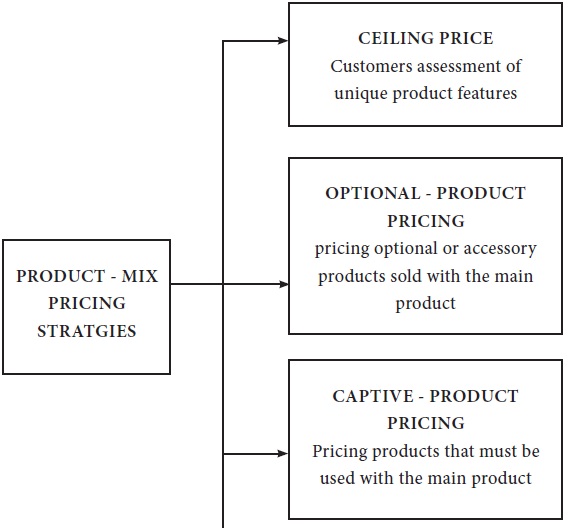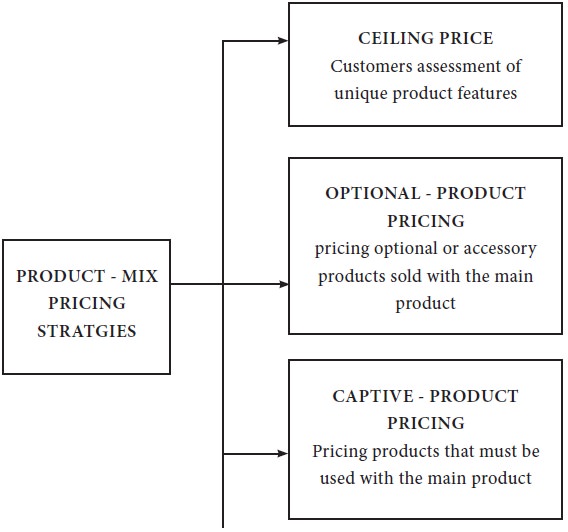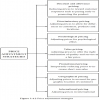MARKETING MANAGEMENT - Pricing Methods
Product-Mix pricing - Pricing Methods
Posted On :

The strategy for setting a product’s price often has to be changed when the product is part of a product mix.
Product-Mix pricing
The strategy for setting a product’s price often has to be changed when the product is part of a product mix. In this case, the firm looks for a set of prices that maximizes the profits on the total product mix. This pricing is difficult because the various products have related demand and costs and face different degrees of competition. The following section outlines the five product-mix pricing situations depicted in Figure 3.4.1


Since most firms market multiple product lines, an effective pricing strategy must consider the relationships among all of these products instead of viewing each is isolation. In product line pricing, management must decide on the price steps to set between the various products. The price steps should take into account cost differences between the products, customer evaluations of their different features and competitors’ prices.
In many industries, marketers use well-established price points for the products in their line. The customer will probably associate low, average and high quality with the price points. The marketers task is to establish perceived quality differences that support the price differences.
Many firms use this strategy by offering to sell optional or accessory products along with their main product. These firms have to decide which items to include in the base price and which to offer as options. Often the basic model which is stripped of many comforts and conveniences sought by the customers gets rejected.
Firms that make products that must be used along with a main product are using this pricing strategy. Producers of the main products often price them low and set high markups of the supplies. For a competitor who does not sell these supplies, he will have to price his product higher in order to make the same overall profit.
In case of services, this strategy is called two-part pricing where the price of the service is broken into a fixed fee plus a variable usage rate. The service firm must decide how much to charge for the basic service and how much for the variable usage. The fixed amount should be low enough to induce usage of the service and profit can be made on the variable usage fees.
In producing certain products, there are by-products. If these by products have no value and if getting rid of them is costly, this will affect the pricing of the main product. Using by-product pricing, the manufacturer will seek a market for these by-products and should accept any price that covers more than the cost of storing and delivering them. This practice allows the marketer to reduce the main product’s price to make it more competitive.
Using this strategy, marketers combine several of their products and offer the bundle at a reduced price. Price bundling can promote the sales of products consumers might not buy otherwise, but the combined price must be low enough to get them to buy the bundle.
The strategy for setting a product’s price often has to be changed when the product is part of a product mix. In this case, the firm looks for a set of prices that maximizes the profits on the total product mix. This pricing is difficult because the various products have related demand and costs and face different degrees of competition. The following section outlines the five product-mix pricing situations depicted in Figure 3.4.1


Since most firms market multiple product lines, an effective pricing strategy must consider the relationships among all of these products instead of viewing each is isolation. In product line pricing, management must decide on the price steps to set between the various products. The price steps should take into account cost differences between the products, customer evaluations of their different features and competitors’ prices.
In many industries, marketers use well-established price points for the products in their line. The customer will probably associate low, average and high quality with the price points. The marketers task is to establish perceived quality differences that support the price differences.
Optional-product pricing
Many firms use this strategy by offering to sell optional or accessory products along with their main product. These firms have to decide which items to include in the base price and which to offer as options. Often the basic model which is stripped of many comforts and conveniences sought by the customers gets rejected.
Captive-product pricing
Firms that make products that must be used along with a main product are using this pricing strategy. Producers of the main products often price them low and set high markups of the supplies. For a competitor who does not sell these supplies, he will have to price his product higher in order to make the same overall profit.
In case of services, this strategy is called two-part pricing where the price of the service is broken into a fixed fee plus a variable usage rate. The service firm must decide how much to charge for the basic service and how much for the variable usage. The fixed amount should be low enough to induce usage of the service and profit can be made on the variable usage fees.
By-product pricing
In producing certain products, there are by-products. If these by products have no value and if getting rid of them is costly, this will affect the pricing of the main product. Using by-product pricing, the manufacturer will seek a market for these by-products and should accept any price that covers more than the cost of storing and delivering them. This practice allows the marketer to reduce the main product’s price to make it more competitive.
Product-bundle pricing
Using this strategy, marketers combine several of their products and offer the bundle at a reduced price. Price bundling can promote the sales of products consumers might not buy otherwise, but the combined price must be low enough to get them to buy the bundle.
Tags : MARKETING MANAGEMENT - Pricing Methods
Last 30 days 1170 views













